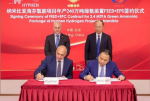Namibia’s bold vision to transform itself from a raw material exporter into a continental green industrial powerhouse is rapidly gaining traction, propelled by strategic studies, significant funding inflows, and tangible early successes in its burgeoning green hydrogen sector. With over N$2.08 billion already invested and key pilot projects coming online, the Namibia Green Hydrogen Programme (NGH2P) is leveraging critical research to unlock a future defined by high-value exports, mass employment, and global climate leadership.
The commissioning of the Hylron-Oshivela facility near Arandis in March 2025 marked a watershed moment, producing sub-Saharan Africa’s first green hydrogen-powered iron. Its 12 MW electrolyser, the largest in the southern hemisphere, stands as a physical testament to progress. “This project not only contributes to the global fight against climate change but also underscores Namibia’s commitment to a carbon-free economy,” declared President Dr. Netumbo Nandi-Ndaitwah. “By shifting from raw material exports to local value-added production, Namibia will generate six to eight times more economic value.” This shift is being meticulously guided by a suite of foundational studies pinpointing optimal pathways for industrial development.
Crucial pre-feasibility studies, funded by NGH2P, are laying the groundwork for large-scale investment. The Neckartal Dam Fertiliser Green Scheme study confirmed the viability of local ammonia and fertiliser production, promising to slash imports and bolster national food security – a goal already advanced by the fully operational Daures Green Hydrogen Village pilot, set to supply one-third of Namibia’s fertiliser needs. Simultaneously, the Gigawatt-Scale Green Hydrogen Plant study identified prime sites outside the Tsau //Khaeb National Park (TKNP) for massive production hubs targeting green steel, agriculture, mineral beneficiation, and regional power exports. Further unlocking potential, an offshore wind feasibility study revealed an estimated 20-35 GW capacity near Lüderitz, paving the way for pilot projects to build local expertise. To ensure future projects are built on solid data, a N$50 million wind measurement campaign within the TKNP is underway, collecting vital resource data over 12-24 months to de-risk major investments.
Understanding that world-class infrastructure is paramount, the NGH2P secured N$3.6 million from Germany for a best-practice study on Common User Infrastructure (CUI) – pipelines, desalination plants, rail, ports, and energy corridors. Expected by end-June 2025, this study will guide NamPower, NamWater, NamPort, and TransNamib in integrated planning. Complementing this, a landmark cross-border pre-feasibility study confirmed the feasibility of a hydrogen pipeline linking Lüderitz, Boegoebaai (South Africa), and Saldanha Bay, creating a resilient Southern African hydrogen backbone with a conceptual master plan slated for mid-2025. Port readiness is also accelerating, with NamPort signing strategic MoUs with Rotterdam and Antwerp-Bruges to develop Angra Point in Lüderitz and upgrade Walvis Bay’s North Port, positioning Namibia as a key green ammonia export gateway. Funding from GIZ further supports developing a National Maritime Decarbonisation Action Plan.
This strategic foundation is attracting substantial capital. Beyond the N$2.08 billion already invested in projects, Namibia achieved a major coup by ranking 3rd globally among 26 nations in the Climate Investment Funds’ (CIF) competitive selection process. This grants access to the CIF Industry Decarbonization Programme (IDP), offering concessional finance up to USD 250 million at approximately 1% interest, capable of leveraging up to ten times that amount from multilateral banks. “This underscores the maturity of the work undertaken since 2021 by Government in partnership with private sector stakeholders,” stated James Mnyupe, Head of the NGH2P. An additional EUR 12 million, stemming from Hyphen Hydrogen Energy’s land lease agreement under the Feasibility and Implementation Agreement (FIA), is expected to be allocated to the NGH2P to further sector development. Donor confidence remains strong, with close to USD 125 million secured since 2022 from Germany, the EU, the Netherlands, and others for programme operations, strategy development, scholarships, and the SDG Namibia One Fund.
The benefits are already materialising at the grassroots level. Over 800 Namibians have gained employment in pilot and early-stage green hydrogen projects. Approximately N$170 million has flowed into local small and medium enterprises (SMEs), stimulating entrepreneurship and local value chain development. The Youth for Green Hydrogen Scholarship Programme, funded via a German partnership, has awarded 183 scholarships for green transition-related studies at TVET and university levels, with a further EUR 1.3 million earmarked for regional TVET training initiatives in Hardap and |Karas. Capacity building extends to research, with approximately EUR 2 million secured to fully operationalise the Namibia Green Hydrogen Research Institute (NGHRI) at UNAM, focusing on safety, sustainability, and local technological innovation.
Looking ahead, 2025 is poised to be a defining year. The draft National Policy on Green Hydrogen and Derivatives, finalised in April 2025 and currently under review by the Ministry of Mines and Energy, is the cornerstone for enabling legislation and a clear regulatory framework expected later this year. The NGH2P, in partnership with Ninety-One, is developing a detailed investment plan aligned with the forthcoming National Development Plan 6 (NDP6) to channel the CIF-IDP funds effectively. Environmental and social safeguards are being rigorously addressed through Strategic Environmental and Social Assessments (SESA) for the Southern and Central Corridors, crucial for securing finance and managing cumulative impacts, especially in ecologically sensitive areas like the TKNP. An ESG policy is also under development for finalisation in Q3 2025 to ensure impeccable sustainability standards.
Major final investment decisions for projects like Hylron and Cleanergy are anticipated this year, signalling the potential shift from pilots to commercial scale. The government aims to complement private investment by mobilising catalytic concessional finance to reduce capital costs across the ecosystem and finalise a competitive fiscal regime. “The year 2025 is the year the industry could lay the real foundation for attaining escape velocity, departing the realms of piloting and entering the era of commercial scale,” the NGH2P report asserts. Domestically, the Global African Hydrogen Summit in Windhoek this September will showcase progress, while internationally, platforms like TICAD and COP30 offer stages for Namibia’s green ambition. Ultimately, the NGH2P envisions transitioning into a self-sufficient continental centre of excellence, sharing hard-won lessons and mobilising capital to champion Africa-wide green industrialisation, turning vulnerability to climate change into a powerhouse of sustainable opportunity.










